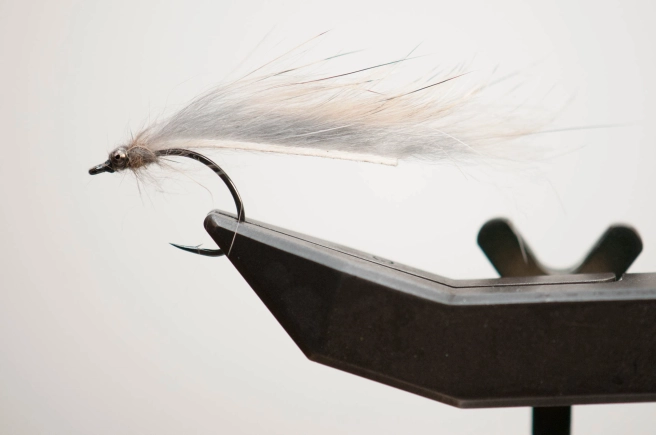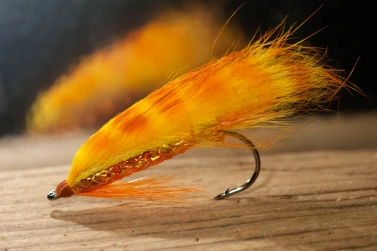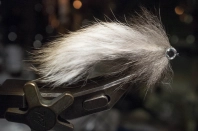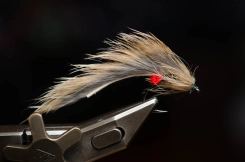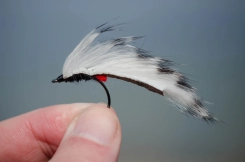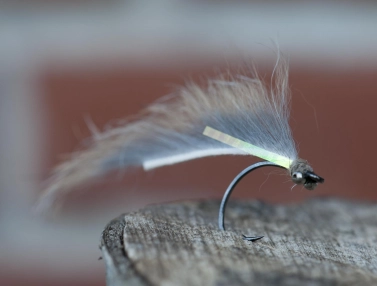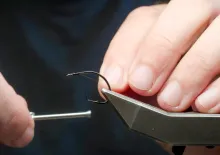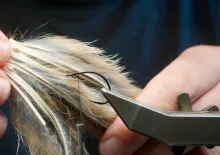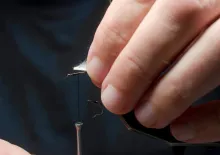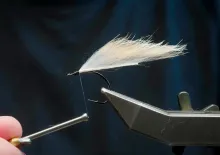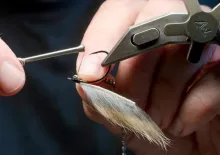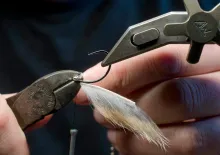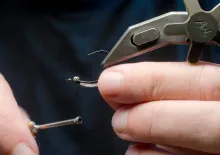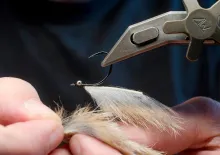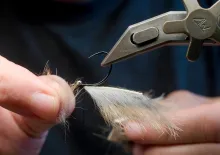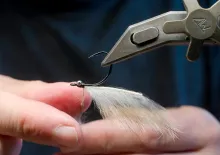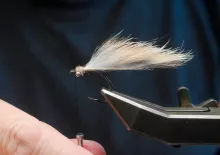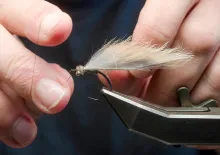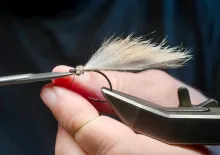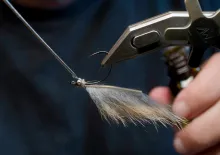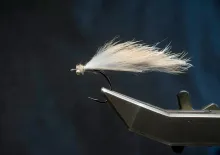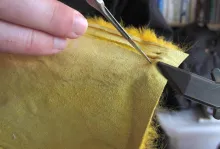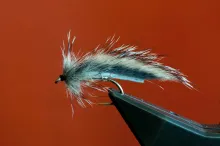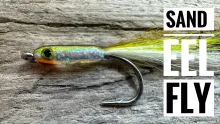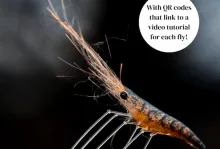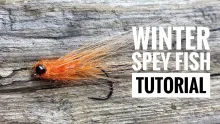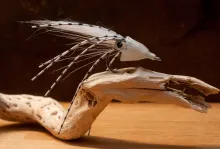A really simple and easy little baitfish fly, which will work for a lot of different fish and can be varied endlessly
I have always loved zonkers and I have tied and fished so many of them that I have lost count a long time ago. Not that I ever started counting, actually…
Zonkers are great looking flies, utilizing a fantastic material in an ingenious way.
My standard zonker
My standard zonker is basically always a long shank hook, a body, a rib to hold the skin strip down and a hair hackle to cover up the mess where the strip is tied off. Many of my zonkers have eyes, mostly simple bead chain eyes, which is what I use for most of my sea trout flies.
Tying in a zonker strip with a rib might seem simple, but it can actually be quite challenging and hard to get to look nice. The rib has to be evenly spaced, and not squash down too many hairs It mustn't curl the skin and it shouldn't mess up the body. The body has to be smooth and even, and although I love giving myself a hard time by tying a smooth and shiny tinsel body under the strip, this can pose quite a problem to some tyers, struggling to get the foundation for the strip even and nice.
No glue on my flies
I see all kinds of recommendations for getting zonker strips to sit nicely, most of them including glue, which in my eyes is a total no-no. Some patterns – including some that I tie – omit the rib, and prescribe tying down the strip fore and aft. I'm not totally fond of this method either, mostly because the strip over the body will often hang when getting wet and soggy, and secondly because it requires that you cut and tie in the thread a second time, and that you varnish over the wraps in the rear of the fly, oftentimes varnishing the hair and the skin.
No snazzy trick
This specific pattern doesn't solve the zonker issue by recommending a snazzy way of tying it down and controlling it. It simply leaves out the tying down thing and lets the strip flow freely. For this to work, you need to use a short zonker strip, and also a short hook. I often use grub hooks or short shanked carp hooks.
The idea is that you simply tie down the strip in the front and let it dangle freely in the rear. In this pattern you also cover the skin strip base with dubbing, so there's no spinning a hair hackle or even wrapping a feather.
The forefathers
The forefathers of this fly were all kinds of short hook zonkers, some with hair hackles, some with a traditional front hackle, some even with a muddler head of spun deer hair. Some were quite dense and beefy, but the easiest one to tie and fish was the skinniest one I tied. Hence the name Zkinny – a skinny zonker.
Zonkers imitate small fish very well. Once the skin strip is soaked, it will move seductively and its long hair will undulate and breathe.
Eyes
For the imitation to seem more like a fish, I mostly add eyes. I have used both stick-on eyes as well as various painted dumbbell eyes, but on the Zkinny I have settled for the inexpensive and easy-to-use bead chain eyes. These are the stable eyes on my sea trout flies, and have worked perfectly for decades. They add the visual impression of eyes and pupils, and add a bit of weight to the front of the fly, balancing the hook, and even giving a slightly jiggy motion when the fly is retrieved.
Short zonker strips
As mentioned a key to less Zkinny zonker hassle is short zonker strips. Don't make the skin more than 1.5-2 centimeters or about 1/2-3/4 of an inch in length. I like cutting my own strips, enabling me to get them very narrow, but you can of course use commercial strips.
One key to a good looking Zkinny is indeed to keep it skinny, and a narrow skin strip is one of the keys.
Choose the narrowest you can find, preferably 2-3 millimeters or 1/8" wide, and consider tapering the rear end they are wider. If the strips you have are really wide, try to simply dividing them in two using a scalpel. It might sound difficult, but for the short bits we need here, it's not that hard to split the leather side of a strip.
Skin choice
You can use most zonker strips you can get as long as the skin is thin and flexible (tanned) and the hairs are soft and has enough underfur. I have used rabbit, nutria (coypu), squirrel and mink with good luck. The problem is getting the pre-cut strips narrow enough. Consider buying skins and cutting your own.
The longer the hair, the shorter you can cut the skin, and some types like Finn racoon or fox, you need almost no skin to get a sufficiently long "wing".
Color and bling
These days zonker strips are available in all kinds of colors, and some are even striped. The Zkinny can essentially be tied in any color you please, but personally I prefer natural colors like tan and light gray. I have tied the fly in white, black and olive and it looks great, but for imitations, the less colorful versions do the best job.
I have added a bit of bling to some flies in the form of some stiff flash "cheeks", which will add some shine on the side of the fly and imitate the shiny side of some small baitfish. You can also add a red "false hackle" made from yarn to mimic the bared gills of a small fry.
|
|
|
|
|
|
|
|
|
|
|
|
|
|
|
|
|
|
|
|
|
|
|
|
Fishing the Zkinny
The fly is fished like most sea trout flies: cast it out and leave it dead for a second or two. The fly sinks slowly and should a fish have been attracted by the gentle plop of the landing, it will see a small fish still in the water. Pull in a foot or so of line and repeat. After the first couple of strips and pauses, you can strip consistently until the fly is close enough for the next cast. Make sure you see the fly when lifting it for the next cast. Many a coastal angler has been taken by surprise by a fish, attacking the fly, suddenly speeding up because it's on its way into the air following the line being pulled up for a new cast.
The Zkinny best imitates a small goby, but can stand in for a sand eel, and can be fished low or high, slow or fast, in jerks or smoothly depending on what's moving in the water.
Gentle casts
Also make sure the leader is stretched when you cast, which can be obtained by slowing down your casts and opening the line arcs. The fly lands much more subtly, and no big splash or piling up leader will spook a fish nearby. The fly also fishes immediately on the first strip, and the stretched leader usually also means that the fly lands head front and tail to the back, avoiding the dreaded curled up fly or fly that has caught itself or the line in the cast.
Luckily the Zkinny is quite hassle free in spite of the loose zonker strip, and mostly fishes as it should. But do yourself the favor of checking it now and then to make sure everything is in order before a new cast.
Soak me, baby!
Once the fly has been fished, especially in salt water, the skin will most likely dry up hard and stiff. Don't worry about this, but make sure you soak the fly before tying it on while fishing, so that it's soft and flexible from the start.
I usually take out a zonker that I intend to fish and dip it in the water before cutting off the fly I have on. While I'm preparing tippet and stowing away the old fly, the zonker sits on my fly patch and softens a bit, and will be ready to perform the second it hits the water.
Martin Joergensen
Hand picked for this article
- Log in to post comments

